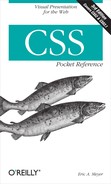Layout of Absolutely Positioned Elements
In the following sections, these terms are used:
- Shrink-to-fit
Similar to calculating the width of a table cell using the automatic table layout algorithm. In general, the user agent attempts to find the minimum element width that will contain the content and wrap to multiple lines only if wrapping cannot be avoided.
- Static position
The place where an element’s edge would have been placed if its
positionwerestatic.
Horizontal layout of nonreplaced absolutely positioned elements
The equation that governs the layout of these elements is:
left + margin-left + border-left-width + padding-left + width + padding-right + border-right-width + margin-right + right = width of containing block
The steps used to determine layout are:
If all of
left,width, andrightareauto, first reset anyautovalues formargin-leftandmargin-rightto0. Then, ifdirectionisltr, setleftto the static position and apply the rule given in step 3c. Otherwise, setrightto the static position and apply the rule given in step 3a.If none of
left,width, andrightisauto, pick the rule that applies from the following list:If both
margin-leftandmargin-rightare set toauto, solve the equation under the additional constraint that the two margins get equal values.If only one of
margin-leftormargin-rightis set toauto, solve the equation for that value.If the values are overconstrained (none is set to
auto), ignore the value forleftifdirectionisrtl(ignorerightifdirectionisltr) and solve for that value.
If some of
left,width, andrightareauto, but others are not, reset anyautovalues formargin-leftandmargin-rightto0. From the following list, pick the one rule that applies:If
leftandwidthareautoandrightis not, then the width is shrink-to-fit. Solve the equation forleft.If
leftandrightareautoandwidthis not, then ifdirectionisltr, setleftto the static position (otherwise, setrightto the static position). Solve the equation forleft(if direction isrtl) orright(ifdirectionisltr).If
widthandrightareautoandleftis not, then the width is shrink-to-fit. Solve the equation forright.If
leftisautoandwidthandrightare not, solve the equation forleft.If
widthisautoandleftandrightare not, solve the equation forwidth.If
rightisautoandleftandwidthare not, solve the equation forright.
Vertical layout of nonreplaced absolutely positioned elements
The equation that governs the layout of these elements is:
top + margin-top + border-top-width + padding-top + height + padding-bottom + border-bottom-width + margin-bottom + bottom = height of containing block
The steps used to determine layout are:
If all of
top,height, andbottomareauto, settopto the static position and apply the rule given in step 3c.If none of
top,height, andbottomisauto, pick the one rule that applies from the following list:If both
margin-topandmargin-bottomare set toauto, solve the equation under the additional constraint that the two margins get equal values.If only one of
margin-topormargin-bottomis set toauto, solve the equation for that value.If the values are overconstrained (none is set to
auto), ignore the value forbottomand solve for that value.
If some of
top,height, andbottomareauto, but others are not, pick the one rule that applies from the following list:If
topandheightareautoandbottomis not, then the height is based on the element’s content (as it would be in the static flow). Reset anyautovalues formargin-topandmargin-bottomto0and solve the equation fortop.If
topandbottomareautoandheightis not, then settopto the static position. Reset anyautovalues formargin-topandmargin-bottomto0and solve the equation forbottom.If
heightandbottomareautoandtopis not, then the height is based on the element’s content (as it would be in the static flow). Reset anyautovalues formargin-topandmargin-bottomto0and solve the equation forbottom.If
topisautoandheightandbottomare not, reset anyautovalues formargin-topandmargin-bottomto0and solve the equation fortop.If
heightisautoandtopandbottomare not, reset anyautovalues formargin-topandmargin-bottomto0and solve the equation forheight.If
bottomisautoandtopandheightare not, reset anyautovalues formargin-topandmargin-bottomto0and solve the equation forbottom.
Horizontal layout of replaced absolutely positioned elements
The behaviors that go into placing and sizing replaced elements are most easily expressed as a series of rules to be taken one after the other. These rules state:
If
widthis set toauto, the computed value ofwidthis determined by the intrinsic width of the element’s content. Thus, the width of an image 50 pixels wide is computed to be50px. Ifwidthis explicitly declared (that is, something such as100pxor50%), then the width is set to that value.If
lefthas the valueautoin a left-to-right language, replaceautowith the static position. In right-to-left languages, replace anautovalue forrightwith the static position.If either
leftorrightis stillauto(in other words, it hasn’t been replaced in a previous step), replace anyautovalue inmargin-leftormargin-rightwith0.If at this point both
margin-leftandmargin-rightare still defined to beauto, set them to be equal, thus centering the element in its containing block.After all that, if there is only one
autovalue left, change it to equal the remainder of the equation.
Vertical layout of replaced absolutely positioned elements
The behaviors that go into placing and sizing replaced elements are most easily expressed as a series of rules to be taken one after the other. These state:
If
heightis set toauto, the computed value ofheightis determined by the intrinsic height of the element’s content. Thus, the height of an image 50 pixels tall is computed to be50px. Ifheightis explicitly declared (that is, something such as100pxor50%), then the height is set to that value.If
tophas the valueauto, replace the value with the replaced element’s static position.If
bottomhas a value ofauto, replace anyautovalue onmargin-topormargin-bottomwith0.If at this point both
margin-topandmargin-bottomare still defined to beauto, set them to be equal, thus centering the element in its containing block.After all that, if there is only one
autovalue left, change it to equal the remainder of the equation.
